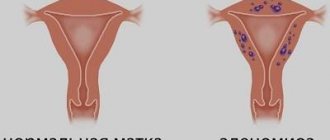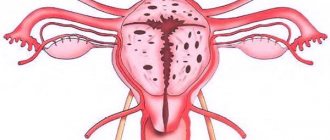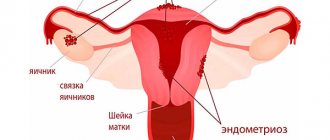Known types and degrees of endometriosis What contributes to the development of endometriosis Symptoms and signs of endometriosis Endometriosis during pregnancy - a risk or an opportunity? Diagnosis and treatment
One of the most common gynecological diseases is endometriosis. This disease is characterized by the proliferation of endometrial tissue, the inner layer of the walls of the uterus. The danger is that the growth is pathological and largely depends on the woman’s hormonal background. Growing endometrial tissue can grow into the uterus itself or, after menstrual bleeding, become established outside the uterus, forming the external type of the disease.
Despite the fact that endometriosis in one form or another occurs in every third woman of reproductive age, the disease remains a big mystery for modern doctors. There are about 10 theories about how the disease arises and develops. However, not a single theory explains the huge variety of forms and places of occurrence of pathology1.
Considering the prevalence of the disease, no woman is immune from its manifestations. Any type of endometriosis significantly complicates conception and the course of pregnancy, and an advanced form can lead to complete infertility.
Endometriosis and pregnancy
Total messages: 45
10/28/2014, Oksana55
I am 34 years old, I also suffered from endometriosis of the uterus, I had an endometrial polyp cleaned twice, spotting in the middle of my cycle, I have to take duphaston and regularly see a gynecologist. There was a problem with pregnancy, I was treated at the Altravita IVF clinic in Moscow. She went through IVF twice, pregnancy occurred after the second attempt, and a son was born. So don’t despair, look for your doctor, there is always hope!
10/19/2012, Tati
After an ultrasound and visual examination, without a single analysis, the doctor, Doctor of Sciences, diagnosed Adenomyosis and prescribed Duphaston from the 14th day, 2 tablets. 10 days. repeat 6 months. I am 37 years old. Never before have I been prescribed hormonal medications so quickly. Scary.
01/30/2012, Sad
I am 26 years old, 3 years ago I found out about my illness, at that time I could not even imagine what the word “ENDOMITRIOSIS” meant to me and what it threatened me with))) I followed the doctors’ instructions, lapra, injections. As of today, 2 years have passed since the lapra, but there is no use, pregnancy does not occur. I read a lot on forums about how this disease progresses in each of us and what consequences lie in wait for each of us. One thing is clear that everything is individual, we can do the same injections, but each has its own result! How hard it is to wait every month. I think it is necessary to take some measures, but I don’t know what to do.
04/28/2012, Milana
Hello!! I'm only 26 years old. I have been married to my husband for 1.5 years. In August, I fell down the stairs and broke my tailbone, so he pushed me to undergo an EMR examination, where they told me that I had a terrible diagnosis - ENDOMETRIOSIS. I decided to confirm my diagnosis, in case it was wrong, so I went for an ultrasound. But the ultrasound doctor says that I have nothing! The doctor who performed the MRI on me sent me to the oncology department for a repeat ultrasound. There the diagnosis was confirmed. (Moreover, there was no clinic and there is no one to this day) They prescribed the drug ZHANIN without a break for 6 months, in the 4th month the body could not stand it and menstruation began on its own. I went again for an ultrasound, where the doctor asked me: Have YOU tried to get pregnant? "I tell her. NO, before this my husband and I constantly used protection, everyone thought it was too early for us (we are fools). If only I had known, we would have started trying right after the wedding! To which the doctor said that the best cure for endometriosis is pregnancy. So I gave up everything and we started trying, we’ve been trying for 4 months now, but nothing has worked out yet :-(( They advised me to use treatment with leeches, they put them on the cervix. When I think that they will drink blood in me, it becomes so bad. I think , the child is worth it. After all, it is happiness to be a mother. I will start in JUNE, the doctor promised a 100% cure for this disease in 7-10 sessions. I want to believe that everything will work out! Has anyone tried this method of treatment.
06/08/2013, Alyonushka
How I understand you! I NEARLY LOCKED MY CONSCIOUSNESS when I was first given just 2 leeches in 2009! But the result exceeded all my expectations! If interested, write questions to me! The local clinic predicted a joint replacement! I was 40 years old then! I could barely walk! And after 4 sessions of leeches (in 2 months they put on 4&'247;5 leeches) I resumed my favorite DANCES! Are you afraid of blood loss? AS a practitioner, I enlighten myself and my clients: 1 individual sucks out a maximum of 15 ml of blood and disappears on its own! In total, even 10 leeches will suck out 150 ml of blood, and donors donate 400 ml! Do you see the difference? All gynecology can be treated perfectly with leeches. You can be convinced by reading the books of doctor Vladimir Alekseevich Savinov = our luminary in hirudotherapy now! Especially endometriosis! The one who walks will master the road!
03/15/2013, Miss
I am 24! It didn’t work out for a year - endometriosis! Today I found out that I am pregnant! Hope and believe in miracles! Good luck!
02/08/2012, Olya
Is everything okay with your husband’s productive system? Has he been examined?
11/10/2011, Olga
I am treated as follows: Janine + Stella + leeches. The result made itself felt immediately after the first 11-day course of leeches. The endometriosis cyst has decreased by more than 2 times (from 20 mm to 9 mm). Now I am taking the second course and believe in a complete cure thanks to leeches.
08/31/2011, nina
I beat endometriosis. lapara + hormones .. gave birth to a healthy boy! I wish everyone health and patience!
09/07/2012, Nika
Please tell me how long after you started planning your pregnancy after laproscopy. Different gynecologists tell me differently: some in a year, some in six months, some in a month
All pages discussing this topic:
1 2 3 4 5
https://youtu.be/3Obi_uKuKZw
Favorable course of pregnancy with endometriosis
On the entire inner surface of the uterus there is a mucous membrane called the endometrium. With hormonal or menstrual disorders, genetic predisposition and other reasons, the endometrium spreads outside the uterus. This disease is called endometriosis.
You can often come across the statement that endometriosis can be treated by pregnancy. This is partly true, because the period of waiting for a child has a beneficial effect on the condition of the uterus, because during this time the cyclic production of hormones, which led to the growth of the mucous membrane, stops. Endometrial growth activity decreases, and the size of the lesions may even decrease. But in most cases this is a temporary phenomenon that will last until ovulation occurs. Therefore, it is still better to neglect this method of treatment and plan to conceive no earlier than six months after treatment.
What is endometriosis
With the disease, endometrioid tissue grows outside the uterus, affecting other organs. The presence of these cells in other organs and tissues gives rise to painful phenomena, including dangerous ones. During the menstrual cycle, the tissue goes through absolutely all changes, just like the endometrium. Gradually it affects surrounding organs.
The disease occurs in 2 out of 20 women of reproductive age. The development of endometriosis depends on hormonal levels. If symptoms are ignored, the disease often leads to infertility.
When the pathology affects the genitals, it is called genital.
This form has several types:
- internal - damage to the muscular layer of the uterus;
- peritoneal - proliferation of endometrial tissue into the fallopian tubes, ovaries and pelvic peritoneum;
- extraperitoneal - the appearance of pathology in the external organs of the reproductive system, the vaginal part of the cervix and the retrovaginal septum.
If the disease is severely advanced, endometrioid lesions become diffuse. In this case, pregnancy is highly doubtful.
To make a diagnosis, a specialist performs an ultrasound.
The gravid endometrium, ready for conception, should be loose and three-layered. This structure ensures implantation of the fertilized egg and its subsequent development.
The doctor also evaluates the thickness of the endometrium. Normally it should be 8-10 mm.
If the uterine mucosa is thin, they speak of hypoplasia. Usually its size does not exceed 6-7 mm. If it is lush and thick, the specialist suspects hyperplasia or polyps.
Some women are sure that hyperplasia of the uterine mucosa and endometriosis are the same thing. In fact, these are different concepts. Their main difference is that in the first case, the pathology affects the organ at the morphological level. With endometriosis, changes occur in the uterus itself, not in the cells.
To make a correct diagnosis, laboratory diagnostics are performed. The doctor performs a core biopsy and examines the material under a microscope.
Is it possible to conceive with endometriosis?
Many women cannot conceive a child for a long time in the presence of foci of endometrial spread. Why? There are several reasons:
- Lack of ovulation. Menstruation goes on as usual, spotting is regular, but true ovulation does not occur due to dysfunction of the ovaries or difficulties in the passage of the egg through the fallopian tubes. This problem usually occurs with an endometrioid ovarian cyst.
- Disturbances in the implantation of a fertilized egg. The diagnosis in this case is adenomyosis. In this case, miscarriage occurs rather than infertility as such, and an ectopic pregnancy can also develop.
- Disturbances in the endocrine system of the body. They simultaneously lead to the spread of the endometrium and cause infertility.
Don't despair! Pregnancy and endometriosis can coexist. This will happen if ovulation, fertilization has occurred, and the egg was still able to pass into the abdominal cavity and implant.
It must be remembered that termination of pregnancy can worsen the course of the disease and lead to an increase in lesions. Therefore, with this diagnosis, you need to very carefully monitor contraception in cases where the child is not wanted.
Features of childbirth with endometriosis
When pathology develops, doctors use a special approach to delivery. During the passage of the child through the birth canal, uterine bleeding is sometimes provoked.
To protect the expectant mother from a life-threatening condition several days before the expected birth, specialists perform an ultrasound on the woman. Such a study makes it possible to assess the condition of the uterus and placenta.
Often, obstetricians and gynecologists perform a cesarean section on a woman in labor. Such an intervention eliminates the development of severe complications. During the operation, doctors prevent the aspiration of endometrioid cells into the patient’s abdominal cavity.
How does endometriosis affect pregnancy?
Experts believe that in this case the likelihood of miscarriage increases. But medicine is now at a fairly high level, so an experienced doctor can help a woman avoid termination of pregnancy. The expectant mother may have to take hormonal medications. Don't be afraid, this is necessary for the safety of your child.
If the uterine mucous tissue has not spread to the placenta, then the chance of saving the baby increases many times over. But in any case, it is necessary to monitor the woman’s condition and, if necessary, prescribe treatment.
Do you have endometriosis and find out you are pregnant?
Contact your gynecologist as soon as possible so that he can give you a referral for an ultrasound. First you need to confirm the fact of intrauterine pregnancy. In the case of an ectopic, an urgent endoscopic operation is performed and the fertilized egg is removed from the tube. An interesting point: after this intervention, the adhesions in the fallopian tube are cut, and in the future the woman’s chance of becoming a mother increases. If everything is in order, then treatment is usually not prescribed in the first trimester.
In the 2-3 trimesters, estrogens suppress the production of progesterone and there is a risk of miscarriage. Therefore, at this stage it is necessary to take progesterone drugs to help reduce the muscle activity of the uterus.
If there is internal endometriosis, then in the last weeks there is a high risk of uterine rupture, so the woman is placed in the prenatal department in order to have an emergency caesarean section if necessary.
As we said above, before planning a new addition to the family, you should definitely cure endometriosis, especially if it is stage 3-4. And in six months, or better yet, in a year, you can begin to achieve your goal. If conception does not occur after complete elimination of the disease, then additional studies must be performed to determine the cause of infertility.
The treatment tactics for endometriosis are chosen by the attending physician depending on the individual characteristics of the woman.
- Hormonal therapy. This type of treatment is based on the suppression of estrogens (female hormones), which lead to the growth of the endometrium outside the uterus. Usually this is a synthetic analogue of progesterone (Duphaston) or other similar drugs with a similar effect. This type of treatment is used for stages 1-2.
- Surgical intervention. It’s sad, but at the moment this is the only and most effective method with which you can completely get rid of foci of endometriosis. Now endoscopic operations are being performed, after which the likelihood of the diagnosis returning is minimal. In Russia, almost all such interventions are performed using laparoscopy. In addition to removing excess endometrium, during surgery they can restore the organ affected by it and separate the adhesions that have appeared. After this type of treatment, hormonal drugs are prescribed.
- Waiting tactics. If a woman already has children or is not planning a pregnancy, and her type of endometriosis is not accompanied by pain symptoms, then this therapy is completely justified. In this case, it is necessary to monitor the condition of the pelvic organs using ultrasound, as well as regularly donate blood for the presence of tumor markers, which indicate the early development of a malignant tumor.
Causes of endometriosis and conception with it
Endometriosis is a fairly common disease that affects every 10 women. It is characterized by growing through the fallopian tubes, cervix, ovaries, intestines and chest cavity, tissues similar in structure to the lining of the uterus.
Very often this pathology becomes the cause of female infertility. You need to know that endometriosis is far from a death sentence! In most cases, after and even before treatment for this disease, pregnancy is possible. However, to save the fetus, you need to identify this disease in your body in time.
Of course, only a doctor can accurately diagnose such a disease. However, you should know the symptoms that will help you identify and treat the source of the disease in time.
Symptoms of endometriosis:
- Pain inside the abdomen that appears periodically;
- Nagging pain in the lower abdomen, perineum and lower back;
- Unpleasant sensations during and after sexual intercourse;
- Bloody discharge from the rectum that appears during menstruation;
- Painful urination;
- Spotting in the middle of the cycle;
- Uncharacteristic color for urine;
- Severe pain during menstruation;
- Brown discharge from the genital tract;
- Sputum and cough with blood.
If several of these symptoms appear, endometriosis can be suspected. In this case, you need to see a doctor and undergo an examination, because timely treatment is the key to a successful recovery.
Itching during pregnancy: 10 reasons for its occurrence
Depending on how old a woman is, endometrial hyperplasia may be stronger or weaker. Where the polyps are located plays a very important role.
Conceiving a child with this disease becomes significantly more difficult. However, if endometriosis is treated on time, you can become pregnant.
The reasons for the development of this disease have not yet been established. The opinion of gynecologists is inclined to believe that the cells that cause this disease enter the abdominal organs during menstruation. Then they spread with blood lymph throughout the body.
Previously, it was believed that this disease only affects women over 40 years of age. However, recent studies have revealed that such a disease also affects the younger half of the fair sex.
There is also an opinion that this disease causes a conscious refusal of girls to conceive a child in the most favorable years. It has been proven that pregnancy and mesopause stop the growth of abnormal tissues.
Endometriosis and pregnancy
Endometriosis is one of the most common gynecological diseases associated with immune and hormonal disorders in the body. It is characterized by the growth of the uterine mucosa (endometrial tissue) outside the uterine cavity, and is expressed in the formation of cysts that appear in those organs where they should not normally be (fallopian tubes, ovaries, bladder, uterine wall).
Endometriosis most often affects women over forty. But sometimes it also occurs in girls who are about to become pregnant in subsequent years. Therefore, correct diagnosis and timely treatment play an important role.
There is still no consensus regarding the nature of the disease. Some structural features of the fallopian tubes, disruptions in the immune system, and hereditary predisposition can contribute to the development of endometriosis.
Symptoms of gynecological disease depend on the individual characteristics of the body. Sometimes a woman does not even realize that she has endometriosis, because it can be asymptomatic. But this happens extremely rarely. In most cases, some symptoms are present. Pain in the pelvis, which is not associated with the menstrual cycle, is one of the common signs of the disease. Sometimes severe pain and discomfort occur during sexual intercourse. The presence of the disease may be indicated by the release of milk-like fluid from the mammary glands, menstrual irregularities, and pain during menstruation.
Symptoms
This disease may be asymptomatic in the initial stages. However, the following symptoms may appear later:
- Long and painful menstruation.
This symptom is especially characteristic of adenomyosis. This is the name for the uterine form of endometriosis, in which endometrial cells invade the muscular wall of the uterus and create lesions there. As a result of this process, the contractility of the uterus decreases, so menstruation lasts a long time and causes pain.
- The appearance of spotting brownish discharge before and after menstruation.
- Tendency to constipation and pain during defecation, especially if endometriotic lesions are located in the retrouterine space, in anatomical proximity to the rectum.
- Pain during sexual intercourse (dyspareunia). This complaint is made by about 50% of patients with endometriosis.
- Chronic pelvic pain is very characteristic of this disease.
Is it possible to get pregnant with endometriosis?
One of the most common and insidious female diseases is endometriosis. This disease manifests itself in the form of a layer of uterine tissue in an unusual place: in the abdominal area, fallopian tube, on the ovaries, and also on the walls of the uterus. Pathological manifestations of endometriosis are especially dangerous when planning pregnancy, since they significantly complicate the process of conception, and in severe cases can provoke infertility. In this regard, endometriosis and pregnancy are considered the most pressing topic among the fair sex.
Endometriosis during pregnancy
Despite the fact that internal endometriosis prevents pregnancy, nowadays there are often cases when doctors in their practice have to observe endometriosis and pregnancy that develops against the background of this disease. Of course, it is easiest to get pregnant with stage 1 endometriosis, while the disease is not very severe.
But still, it should be noted that even if pregnancy occurs with endometriosis, a woman has an increased risk of miscarriage. Most likely, the doctor will prescribe a course of hormones for the entire period of bearing the baby, which will reduce the likelihood of an unfavorable outcome.
Once the placenta is formed, the likelihood of miscarriage is significantly reduced. In order to safely give birth to a healthy child, the expectant mother must listen to all the advice of her gynecologist.
With the right approach to treatment, endometriosis does not affect the development of the fetus.
How does endometriosis manifest and its types?
The symptoms of endometriosis depend on the area of manifestation of the pathological process and the general condition of the girl. According to medical practice, there are cases when the disease occurs without symptoms, and a gynecologist can diagnose it during a routine examination.
The development of endometriosis is characterized by the following symptoms:
- The appearance of pain in the pelvic area - this symptom manifests itself in 25% of women. The pain is clearly localized in a specific place for a long period.
- Painful sensations of a cyclic nature that accompany menstruation - a symptom that worries 50% of patients. A pronounced manifestation occurs on the first day of the menstrual cycle as a result of the following factors: the formation of spasms in the uterine vessel, bleeding in the abdominal area, increased pressure.
- Discomfort during sexual intercourse is present when the pathology affects the uterine ligaments or vagina.
- Menstrual irregularities:
- prolonged, heavy menstruation;
- the presence of brown discharge after menstruation;
- reduction of the menstrual period;
- heavy bleeding.
- The most dangerous symptom is problematic conception and pregnancy. This symptom is present in 40% of girls.
In the presence of severe complications, the manifestation of specific symptoms is observed:
- formation of bloody discharge in the urine;
- impaired bowel movement;
- cough accompanied by hemoptysis.
Endometriosis is considered to be a chronic disease - this is due to the absence of an acute phase. The most common classification consists of two types, each of which includes the following subtypes:
- The genital type is divided into three forms: internal, peritoneal, extraperitoneal. The first subtype, adenomyosis, involves the growth of lesions inside the uterus, with penetration deep into the mucous tissue. In the peritoneal form, other organs of the reproductive system are affected: the cervix and tubes of the uterus, ovaries, vagina. The extraperitoneal subtype involves damage to external organs.
- The extragenital appearance is diagnosed in the case of the formation of pathological foci in the intestines, lungs, and bladder.
Symptoms and signs of endometriosis
In most cases, especially in the early stages of development, endometriosis does not manifest itself in any way, that is, the disease is asymptomatic. It gets to the point that doctors are not even sure of the approximate figures for the prevalence of the disease. Without a clear visual examination, it is possible to suspect endometriosis, but it is extremely difficult to confirm2.
If endometriosis makes itself felt, then the growth has already reached a significant size. Symptoms may be as follows2:
- progressively increasing pain, especially noticeable before or during menstruation;
- discomfort and unpleasant sensations during sexual intercourse;
- pain during bowel movements;
- the presence of spotting before the onset of menstruation;
- short menstrual cycle (polymenorrhea);
- presence of blood in the urine (hematuria);
- impossibility of conception.
If any such symptoms occur, you should immediately contact a gynecologist, since advanced endometriosis is the main cause of infertility and surgical removal of the uterus.
What does the disease lead to?
First of all, endometriosis affects the uterus, as well as the nearest genital organs. Endometrial tissue is sensitive to hormone cells, so the following changes occur in distant areas covered with mucous membrane:
- Endometrial tissue in the uterus grows and becomes dense - this is due to the release of estrogen cells in the first days of the menstrual period.
- The second half of the period is characterized by the influence of progesterone, which destroys the newly formed layer. This process is accompanied by inflammation and bleeding.
Thus, endometriosis of the uterus leads to the formation of cysts, improper functioning of the organs of the reproductive system, and in severe cases jeopardizes the possibility of conceiving a fetus and the normal course of pregnancy.
Planning pregnancy - is it possible?
The negative impact of endometriosis on pregnancy is explained by the high probability of miscarriage, and subsequently infertility. According to medical statistics, 40% of girls suffer from problems associated with conception throughout the year. Against the background of endometriosis, reproductive function is significantly reduced:
- The resulting adhesions in the uterine tubes lead to disruption of the passage of the egg, thereby interfering with conception.
- An excess of prostaglandins in the female body provokes the formation of numerous microspasms that disrupt the transport function of the uterine tubes.
- Hormonal imbalance and decreased immunity interfere with the normal course of ovulation. Pregnancy is possible with complete stabilization of hormonal levels.
- Neoplasms in the form of endometrioid cysts have a negative impact on pregnancy. If the fertilization process is successful, there is a possibility of termination of pregnancy.
The girl’s reproductive function is significantly reduced, but with effective treatment, the body quickly recovers and returns to its previous form. Pregnancy with endometriosis of the uterus is allowed if the patient takes a course of hormonal medications. If the process of natural fertilization is unsuccessful, the doctor advises using the method of in vitro conception.
Treatment of endometriosis during pregnancy
During pregnancy, hormonal levels to some extent “fight” endometriosis. In a woman’s body, the production of estrogen by the ovaries sharply decreases, and the corpus luteum, which is formed during the ovulation process before pregnancy, actively produces progesterone. All these factors contribute to the suppression of endometriosis foci.
If after childbirth a woman breastfeeds, then throughout lactation the production of estrogen is also at a low level, which is a natural therapy for endometriosis. For this reason, in some cases, pregnancy, if not completely cures this disease, then at least provides long-term remission and suppression of the activity of pathological foci.
However, all of the above does not mean that endometriosis can be treated through pregnancy. The risk of possible complications, not to mention the fact that the disease itself can prevent pregnancy, is much higher than the chances of a favorable outcome. Therefore, you should not think about how to get pregnant with endometriosis of the uterus, and when such a diagnosis is made, it is better to start treatment immediately.
Pregnancy after treatment
Treatment of endometriosis is long-term and complex, since surgical and conservative interventions are used. When drawing up an individual methodology, the doctor must take into account the biological age, which is used to determine the possibility of becoming pregnant, as well as the severity of the pathology.
Conservative therapy consists of the use of hormonal medications. To make it easy to get pregnant after endometriosis, it is necessary to eliminate iron deficiency anemia using iron-containing medications. To improve the patient’s general condition, the doctor prescribes painkillers, hemostatic agents, and immunity-boosting drugs.
Surgical intervention is carried out in case of formation of adhesions. In most cases, the doctor uses the method of laparoscopy, which effectively removes the lesion on the affected tissues, but does not injure the body. Pregnancy after treatment of endometriosis proceeds with positive dynamics and without severe complications.
Impact of endometriosis on fertility
If natural conception fails, the doctor prescribes a course of treatment. Many women express concerns regarding the possibility of becoming pregnant after surgery and the desire to preserve the health of the child. Hormonal therapy is not at all dangerous for the unborn fetus. But the ability to conceive may be partially or completely lost as a result of surgery.
The fact is that with a moderate or severe form of the disease, repeated removal of areas affected by endometriosis will be required. Each subsequent operation will lead to scarring on the wall of the uterus, reducing a woman's chances of becoming a mother. If the disease has become severe, removal of the uterus and partial or complete removal of the ovaries is required. After hysterectomy and ovariotomy, fertility is completely lost.
For drug therapy of endometriosis, the drugs of choice are hormonal contraceptive pills. They do not treat the disease, but relieve its symptoms. As soon as a woman stops taking the drugs, her ability to fertilize returns.
Reasons for decreased fertility:
- Formation of an ovarian cyst that prevents ovulation;
- Blocking of tubal patency by endometrial cells;
- Formation of adhesions and scars in the uterus;
- Adhesion due to the inflammatory process, preventing the embryo from attaching to the walls of the uterus.
How does pregnancy and childbirth proceed?
Endometriosis during pregnancy cannot be treated: conservative and surgical methods can have a negative impact on the development of the fetus. According to medical practice, there is an exception, which is the development of an endometrioid cyst affecting the ovary. In order for a woman to be able to bear a fetus, it is necessary to perform surgery in the fourth month of pregnancy.
Carrying a child accompanied by endometriosis should be under the careful supervision of medical specialists. In order to maintain the pregnancy, the girl must take hormonal medications. There are cases when in the early stages there is a threat of miscarriage due to a deficiency of progesterone, which ensures the proper development of the fetus. If the placenta has formed, the pregnancy proceeds positively.
Thus, endometriosis involves the following adjustments during pregnancy:
- with the development of pathology, the chance of such an outcome as an ectopic pregnancy increases significantly. To detect abnormalities in a timely manner, the patient is recommended to undergo an ultrasound;
- Medical professionals should monitor hormonal levels to avoid increased uterine tone. Otherwise, the girl will not be able to give birth;
- a weakened state of the uterus can cause it to rupture as a result of fetal growth. For complete safety, expectant mothers are assigned to inpatient treatment;
- With endometriosis, the birth process becomes much more complicated: since the uterus is not elastic, it is recommended to give birth by caesarean section.
Pregnancy due to endometriosis
If a woman suffering from endometriosis does become pregnant, she has certain risk factors, these include the following conditions:
- Ectopic pregnancy requiring emergency surgical removal of the fertilized egg;
- Hormonal imbalance associated with low progesterone concentrations, which can lead to miscarriage in the 1st and 2nd trimesters. To avoid this, progesterone analogues are prescribed;
- Uterine rupture due to severe thinning of the muscle layer in the later stages. In such cases, a caesarean section is performed.
- Decreased elasticity of the cervix. For this reason, independent delivery becomes impossible, the cervix does not dilate, and a caesarean section becomes necessary.
A pregnant woman suffering from endometriosis should be under the supervision of a doctor throughout her pregnancy.
https://youtu.be/W8TT-geOhvU
Will surgery help you get pregnant?
Modern medicine is impossible without surgical operations, which are divided into conservative interventions and radical interventions. Most often they are combined and used as the most gentle method.
For endometriosis, laparoscopy is most often performed, during which the tumors are cauterized with a special laser. If the disease is accompanied by severe complications, the doctor uses the laparotomy method - cutting the abdominal wall. After surgery, the patient needs to take a course of medication and undergo physical therapy to consolidate the positive result. In general, the operation relieves unpleasant painful sensations, stops the inflammatory process, restores reproductive function, which allows the patient to become pregnant.
IVF as an option for a long-awaited child
The in vitro fertilization program is compiled individually for each patient, based on her biological age, the number of unsuccessful attempts to conceive, her state of health, and the severity of the disease. IVF is contraindicated when external endometriosis is diagnosed. In this case, the woman is given an effective treatment method aimed at reducing symptoms, as well as removing tumors.
If pregnancy does not occur after treatment, the girl is prescribed an in vitro fertilization procedure. For patients over 30 years of age, the procedure is performed after surgery and taking hormonal medications. If the patient is aged 23-27 years, doctors recommend not to rush into IVF and try to conceive a child naturally.
Endometriosis in the final stages of development is not an obstacle to in vitro fertilization. As a rule, the procedure is prescribed immediately after special tests and a thorough examination.










